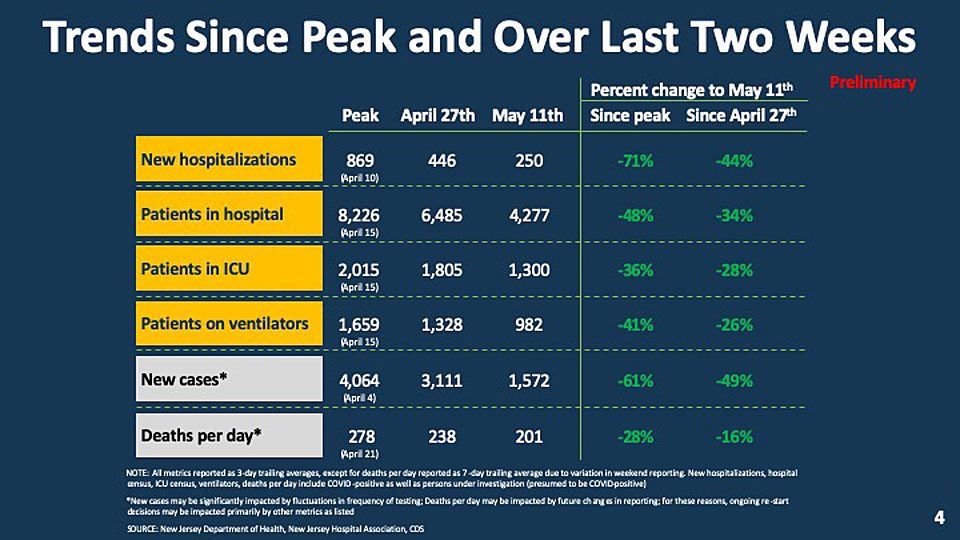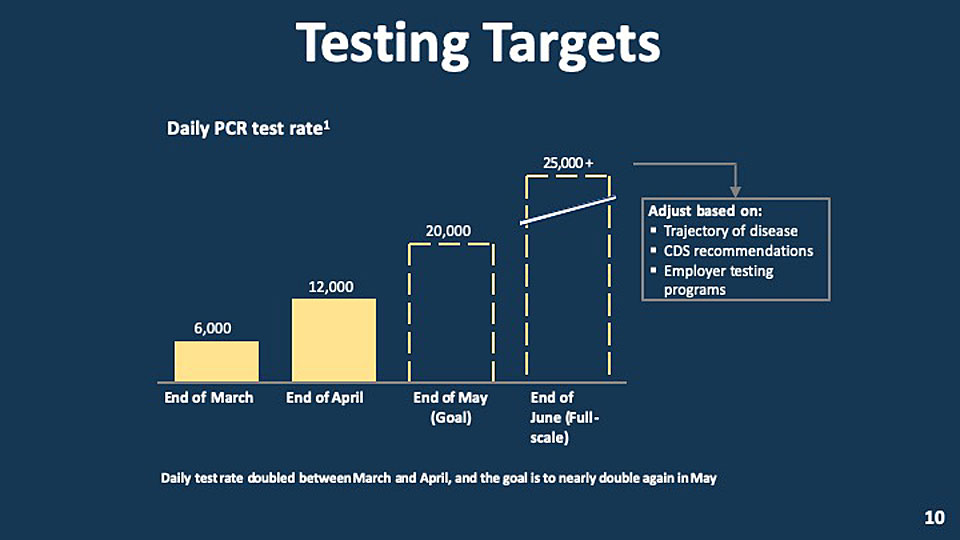This story was written and produced by NJ Spotlight. It is being republished under a special NJ News Commons content-sharing agreement related to COVID-19 coverage. To read more, visit njspotlight.com.
Click here for the original article published on May 13, 2020, written by Lilo H. Stainton.
Long-awaited presentation lacks specifics on measures that will bolster confidence economy can be safely restarted
New Jersey will invest hundreds of millions of dollars to expand COVID-19 testing — prioritized for vulnerable populations, their caregivers, and frontline workers — and hire up to 5,000 people as part of an unprecedented statewide effort to track further spread of the disease, according to state officials.
The announcement Tuesday came as Gov. Phil Murphy outlined the state’s plan for testing and contact tracing, two key aspects of his blueprint for reopening businesses and public spaces as the novel coronavirus shows signs of beginning to recede. Murphy has insisted the timing of the reopening process will be determined by trends in case counts and hospital data, but said he may be able to provide dates for some specific steps later this week.
“No state is as impacted as ours,” Murphy said during his daily media briefing, pointing to a graphic that showed New Jersey leads the nation in new cases, patients and deaths — when computed per capita.
“There are still thousands in our hospital and sadly an untold more will perish,” he said.
Nearly 141,000 New Jerseyans have now tested positive for COVID-19, including more than 9,500 who have died — second only to New York among states.
State officials also took steps Tuesday to beef up testing capacity and screening for the virus at certain facilities. Murphy said he has directed $6 billion in federal funding to Rutgers University to help them scale up — as much as five-fold — production of a saliva-based test kit, allowing it to reach as many as 50,000 people daily.
First steps
The state Department of Health set a May 26 deadline by which nursing homes and assisted-living facilities must have tested all residents and staff for the virus, whether symptomatic or not. Those who test negative must be retested within three to seven days. More than half of the deaths recorded in New Jersey involve a resident of long-term care, according to state figures.
In addition, DOH Commissioner Judy Persichilli said that by May 22 the state would complete universal screening of staff and residents at New Jersey’s four public psychiatric hospitals, which care for more than 1,200 individuals. State figures show 190 residents and 456 employees have already tested positive for COVID-19 at these sites; 12 residents and five staff members have died.
Migrant farmworkers — another vulnerable population that often lives in close quarters —are also a priority, Persichilli said. While information on this group has been scarce, she said 129 workers have been tested so far, and 57 have been positive. Workers at four more farms in South Jersey will be screened this week, she said, thanks to the efforts of a local community clinic and Salem County health officials.
“The combination of expanded testing and contact tracing will increase our ability to quickly identify new cases and take immediate public health measures to interrupt the transmission of the virus, “ Pershichilli said. The state also plans to share more in the weeks to come on its efforts to isolate those who are positive, quarantine individuals who have been in contact with COVID-19 patients, and provide care and support for these residents, officials said.
Limited details
When Murphy announced his “Road Back” blueprint two weeks ago, he stressed that economic recovery would be dependent on public health gains, including a two-week decline in new COVID-19 cases and hospitalizations and a more robust testing and contact-tracing program. The governor also appointed a Restart and Recovery Commission to provide guidance on the process and a separate council to help translate their ideas into action.
But details on this strategy have been limited. Despite his insistence that “data determines dates,” Murphy has declined to say what targets he is seeking to hit in the hospitalization or case numbers in order to proceed with a reopening.
On Tuesday he highlighted statistics showing that new hospitalizations had declined 71% since the peak surge in mid-April and that the number of COVID-19 patients in hospitals dropped by nearly half; critical care cases and ventilator use have also declined by more than a third.

“I don’t have a particular number in mind,” he said, “for the simple reason of what I said a minute ago, this is not an on-off light switch. This is not as though, we’re going to hold back everything until you see X and then you get Y.”
Murphy reiterated the need to double the state’s testing capacity so it can screen 20,000 people a day for COVID-19 by the end of May; by the end of June, he’d like to see 25,000 tests done daily. But he and his staff have declined to say how many tests New Jersey needs to hit those goals. The federal government has pledged to provide 550,000 test kits — and additional swabs for screening — but it’s not clear if those have been delivered, or if that number is sufficient to reach Murphy’s goal.
“Every day we take another step forward to ramp up our testing abilities,” Murphy said. “But we know that even this jump in testing is not enough. We need to have an even more robust testing program that is engrained throughout our communities and which go out to the people as much as the people can go to it.”
The Rutgers saliva test — which was recently approved for at-home use — has already been deployed to screen residents and staffers at state-run centers for disabled individuals and in multiple hospitals. Murphy has indicated this method will continue to be part of the state’s testing response, although it’s not clear where else it will be used.
Prioritizing groups
On Tuesday Persichilli said the DOH has identified three groups to be tested, starting with vulnerable residents — including those in nursing homes, psychiatric hospitals, on farms and in prison, among other group settings. The second priority will be frontline workers, including those in health care, grocery stores, police and fire departments and other essential employees. The last group is the general public.
Officials have sketched out plans for testing among the vulnerable groups, but little has been made public on how the process will be further expanded to reach more frontline workers or, eventually, a greater portion of the general public.

Testing is now available to the public at more than 100 sites statewide. Some continue to screen only those with symptoms, while others — including the two federally run programs, at Bergen Community College and the PNC Bank Arts Center — are now testing those without signs of the disease, as well. In some cases health care or other essential workers are prioritized.
Murphy said Tuesday that commercial drugstores are also offering COVID-19 tests. Eleven Rite Aid locations now offer the process and 50 CVS sites will come online by the end of the month.
The state will also support local testing efforts in six large urban communities, he said, and is seeking to work with faith-based organizations to expand the screening effort. The DOH has also issued an order that enables individuals without a doctor to obtain testing in situations that traditionally require a prescription.
Testing, then follow-up
Testing is only the first step, however. The plan also envisions, when someone is positive for COVID-19, that public health workers will try and identify all the other people and places that individual visited while infected and alert those with whom the infected person had a close contact — defined by state epidemiologists as closer than six feet for 10 minutes or more. Local knowledge, cultural competency and fluency in languages other than English are critical to making this contact tracing process successful.
On Tuesday Murphy also highlighted the state’s effort to build a contact-tracing corps that will supplement the roughly 800 staff and volunteers now doing this work on a local and county level. The governor said the state would tap public health students at Rutgers University and other colleges for assistance, plus contract with a staffing company to hire additional tracers. Their findings will be compiled in a single state database.
Persichilli said the plan called for a “scalable” effort, with anywhere from 1,000 to 5,000 individuals in this role. Rutgers and other colleges are expected to provide more than 500 individuals and the state is looking to hire a company that can identify and recruit additional workers, plus train, deploy and manage the corps.
Murphy said contact tracers will be paid $25 an hour, and will either be employed by the state, Rutgers or the contractor, officials said. (Interested individuals can also sign up online.)
The state will foot the bill for a new technology platform to provide training and data-collection functions for all contact tracers, regardless of where they are deployed, officials said. Their findings will be compiled in a central state database, although the privacy of those who test positive will be protected, according to DOH.
“We’re going to have to use contact tracing unlike it’s ever been deployed before,” Murphy said. “Contact tracing until now was largely a local or regional effort,” he added, praising the work these professionals have done in recent months. “But with the threat of COVID-19, we must now centralize these efforts. We are here to help the local health department, not take them over. Together we can achieve the goals we all want.”

